
Found tipped into the front of Poems of Matthew Arnold (London, 1853) an unpublished handwritten signed letter from the poet to his French friend the writer and anglophile Edmond Schérer.
PAINS HILL COTTAGE, COBHAM, SURREY*. Oct 13th '76
My dear Mr. Scherer
My boy slipped down and was trodden upon at football last March, and was very ill afterwards from some injury to the back. He got well, however, but when I wrote to you we had been disturbed by a sudden return of his pain. We have taken him to Prescott Hewitt** a great surgeon, who says that he must lie in bed till the pain has entirely gone, this upsets the arrangements of a small cottage, as we have to give our invalid the one spare room we have, that he may have more air and space than in his own little room. So we are unable to receive any guests in the house while he is ill, and therefore I was obliged, to my very great regret, to put you off. I fear it will be still a week before we cease to be a hospital but – do let me know what you are doing and how long you stay in England. I cannot easily give up the hope of seeing you here. At any rate I shall meet you at the Athenaeum, I trust; for next week I begin inspecting*** again and shall be in London every day. I have so much to say to you and to hear from you. Most sincerely yours Matthew Arnold.
* Printed at head of notepaper. This was in the beautiful private landscaped park Painshill Park and Arnold rented the cottage from 1873 to 1888.
** In Dickens's Dictionary of London, by Charles Dickens , Jr., (1879) under 'Doctors' Prescott G. Hewitt is noted as Consulting Surgeon at the Evelina Hospital for Sick Children (Southwark Bridge Road.)
***Matthew Arnold was appointed, in April 1851, one of Her Majesty's Inspector of Schools, a job which he worked at until 1886. He once described it as 'drudgery.'




































